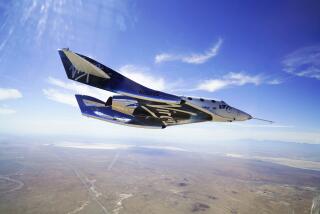In Changing Business World, Only the Adaptable Survive
- Share via
For too long, conventional wisdom held that the San Fernando Valley’s once-proud aerospace industry was doomed. And every indication supported that view. As military contracts dried up and the nation’s interest in space exploration waned, companies as seemingly invulnerable as Rocketdyne and Lockheed began laying off thousands of workers in the early 1990s. For most of this decade, the news has been grim as big projects got cut--and jobs died with them. Over the past year, though, Rocketdyne has rebounded as the beneficiary of changing technological demands and a smart strategy to find business in the private sector.
Rocketdyne’s resurgence highlights the wisdom of careful planning and nimble adaptability by companies both large and small. When spending on defense and space exploration began to wane in the late 1980s and early 1990s, analysts predicted contractors like Rocketdyne would have to find new ways to compete on cost as well as quality if they were to succeed in the open market. Problem was, few could predict just what kind of marketplace would emerge--and it was hard to look forward as companies that put men on the moon put thousands of men and women on the streets.
About 70% of Rocketdyne’s sales are still made to government agencies like NASA. But over the past several years, the company has doubled its sales to commercial clients. This effort got a big boost with the explosive demand for commercial satellites to handle everything from cellular telephone calls to two-way video conferencing. It’s a market few could have foreseen just a few years ago, but Rocketdyne’s expertise in boosters has put it in the forefront. At the same time, the company has reduced costs by boosting efficiency--critical to success not just in the open market, but in the federal government’s new era of cost-consciousness. Space shuttle engines that once took 21,000 person-hours to build now take just 8,000.
Over the past year, Rocketdyne has added 400 new jobs at its Valley facilities and managers are looking to fill another 250 with young hires like 23-year-old Ryan Guerriero, who noted: “What we do goes up there with the stars, sun and moon. . . . Lots of companies make cars or potato chips.” The new hires account for only about 14% of the jobs Rocketdyne eliminated since 1990, but it’s a strong start. The lesson should be clear. Any company can wait for business to find it, but few have the vision--or the stomach--to create business. Successful companies dare to reinvent themselves to prepare for industries few can even imagine. The alternative--counting on today’s skills to survive tomorrow’s challenges--has disastrous results, as employees at big companies like Kodak and local companies like Micropolis found out last week.
Rocketdyne is slowly reinventing itself, and that’s good for the Valley. But reinvention is a process that can’t end, or the layoffs of the early 1990s will loom again the next time the world changes. And change it will.
More to Read
Inside the business of entertainment
The Wide Shot brings you news, analysis and insights on everything from streaming wars to production — and what it all means for the future.
You may occasionally receive promotional content from the Los Angeles Times.










